Calcium Alginate Beads with Entrapped Iron Oxide Magnetic Nanoparticles Functionalized with Methionine—A Versatile Adsorbent for Arsenic Removal
Abstract
1. Introduction
2. Materials and Methods
2.1. Materials and Reagents
2.2. Equipments
2.3. Synthesis of Methionine Functionalized Magnetic Nanoparticles (MFMNPs)
2.4. Preparation of Calcium Alginate Beads with Entrapped Iron Oxide Magnetic Nanoparticles Functionalized with Methionine (MFMNABs)
2.5. Procedure for As(III) Analysis
2.6. Batch Adsorption Studies
2.7. Determination of pHpzc (Point of Zero Charge)
2.8. Adsorption Isotherm
2.9. Adsorption Kinetics
2.10. Regeneration Studies
3. Results and Discussion
3.1. Adsorbent Characterization
3.1.1. X-ray Diffraction
3.1.2. Fourier Transform Infrared Spectroscopy
3.1.3. Scanning Electron Microscopy
3.1.4. Transmission Electron Microscopy
3.2. pH Effect
3.3. Adsorbent Dose Effect
3.4. Contact Time Effect
3.5. Initial Concentration Effect
3.6. Adsorption Isotherm
3.7. Adsorption Kinetics
3.8. Thermodynamic Parameters
3.9. Reusability
3.10. Adsorption Mechanism
4. Comparisons of Adsorption Capacities (qm) of As(III)
5. Conclusions
Author Contributions
Funding
Institutional Review Board Statement
Informed Consent Statement
Data Availability Statement
Acknowledgments
Conflicts of Interest
References
- Xie, L.Y.; Liu, P.; Zheng, Z.Y.; Weng, S.X.; Huang, J.H. Morphology engineering of V2O5/TiO2 nanocomposites with enhanced visible light-driven photofunctions for arsenic removal. Appl. Catal. B Environ. 2016, 184, 347–354. [Google Scholar] [CrossRef]
- Al Salehin, P.Z.; Farid Moeinpour, F.; Mohseni Shahri, F.S. Adsorption isotherm and thermodynamic studies of As(III) removal from aqueous solutions using used cigarette filter ash. Appl. Water Sci. 2019, 9, 172. [Google Scholar] [CrossRef]
- Tien, V.V.; Bay, D.V.; Thu, D.X.; Chung, T.V. Analysis of arsenic from water by spectrophotometric method. Int. J. Dev. Res. 2015, 5, 4987–4991. [Google Scholar]
- Lin, G.; Wang, Y.; Li, G.; Wang, S.; Zhang, H.; Li, B. New System for the Spectrophotometric Determination of Arsenic in Water. In Proceedings of the International Conference on Computer Distributed Control and Intelligent Environmental Monitoring (CDCIEM), Changsha, China, 19–20 February 2011; pp. 385–388. [Google Scholar]
- Guzman, A.; Nava, J.L.; Coreno, O.; Rodriguez, I.; Gutierrez, S. Arsenic and fluoride removal from groundwater by electrocoagulation using a continuous filter-press reactor. Chemosphere 2016, 144, 2113–2120. [Google Scholar] [CrossRef] [PubMed]
- Wu, J.; Zhang, S.D.; Zhu, X.S. Study on the analytical method of inorganic arsenic species in environmental samples. Appl. Ecol. Environ. Res. 2019, 17, 7943–7955. [Google Scholar] [CrossRef]
- Sébastien, S. Time to revisit arsenic regulations: Comparing drinking water and rice. BMC Public Health 2014, 14, 465–477. [Google Scholar]
- Pandey, G.P.; Singh, A.K.; Prasad, S.; Deshmukha, L.; Asthana, A.; Mathew, S.B.; Yoshida, M. Kinetic determination of trace amount of mercury(II) in environmental samples. Microchem. J. 2016, 128, 55–61. [Google Scholar] [CrossRef]
- Nekouei, S.; Nekouei, F. Cloud point extraction and spectrophotometry in the determination of As (III) using amaranth in water samples of rivers located in industrial and non-industrial areas. Curr. Sci. 2014, 107, 1725–1730. [Google Scholar]
- Bhattacharya, P.; Welch, A.H.; Stollenwerk, K.G.; McLaughlin, M.J.; Bundschuh, J.; Panaullah, G. Arsenic in the environment: Biology and Chemistry. Sci. Total Environ. 2007, 379, 109–120. [Google Scholar] [CrossRef]
- WHO. Guidelines for Drinking Water Quality, 4th ed.; World Health Organization: Geneva, Switzerland, 2011; p. 315. [Google Scholar]
- Leupin, O.X.; Hug, S.J. Oxidation and removal of arsenic (III) from aerated groundwater by filtration through sand and zero-valent iron. Water Res. 2005, 39, 1729–1740. [Google Scholar] [CrossRef]
- Bose, P.; Sharma, A. Role of iron in controlling speciation and mobilization of arsenic in subsurface environment. Water Res. 2002, 36, 4916–4926. [Google Scholar] [CrossRef]
- Masue, Y.; Loeppert, R.H.; Kramer, T.A. Arsenate and arsenite adsorption and desorption behavior on coprecipitated aluminum: Iron hydroxides. Environ. Sci. Technol. 2007, 41, 837–842. [Google Scholar] [CrossRef] [PubMed]
- Banerjee, K.; Amy, G.L.; Prevost, M. Kinetic and thermodynamic aspects of adsorption of arsenic onto granular ferric hydroxide (GFH). Water Res. 2008, 42, 3371–3378. [Google Scholar] [CrossRef] [PubMed]
- Sperlich, A.; Werner, A.; Genz, A.; Amy, G.; Worch, E.; Jekel, M. Breakthrough behavior of granular ferric hydroxide (GFH) fixed-bed adsorption filters: Modeling and experimental approaches. Water Res. 2005, 39, 1190–1198. [Google Scholar] [CrossRef] [PubMed]
- Yoon, J.; Amy, G.; Chung, J.; Sohn, J.; Yoon, Y. Removal of toxic ions (chromate, arsenate, and perchlorate) using reverse osmosis, nanofiltration, and ultrafiltration membranes. Chemosphere 2009, 77, 228–235. [Google Scholar] [CrossRef]
- Sanchez-Cantu, M.; Galicia-Aguilar, J.A.; Santamaria-Juarez, D.; Hernandez-Moreno, L.E. Evaluation of the mixed oxides produced from hydrotalcite-like compound’s thermal treatment in arsenic uptake. Appl. Clay Sci. 2016, 121, 146–153. [Google Scholar] [CrossRef]
- Singh, R.; Singh, S.; Parihar, P.; Singh, V.P.; Prasad, S.M. Arsenic contamination, consequences and remediation techniques: A review. Ecotoxicol. Environ. Saf. 2015, 112, 247–270. [Google Scholar] [CrossRef] [PubMed]
- Subramanian, K.S.; Viraraghavan, T.; Phommavong, T.; Tanjore, S. Manganese greensand for removal of arsenic in drinking water. Water Qual. Res. J. Can. 1997, 32, 551–561. [Google Scholar] [CrossRef]
- Yoshitake, H.; Yokoi, T.; Tatsumi, T. Adsorption behavior of arsenate at transition metal cations captured by amino-functionalized mesoporous silicas. Chem. Mater. 2003, 15, 1713–1721. [Google Scholar] [CrossRef]
- Xu, Y.-H.; Nakajima, T.; Ohki, A. Adsorption and removal of arsenic(V) from drinking water by aluminum-loaded Shirasuzeolite. J. Hazard. Mater. 2002, 92, 275–287. [Google Scholar] [CrossRef]
- Elizalde-Gonzalez, M.P.; Mattusch, J.; Einicke, W.-D.; Wennrich, R. Sorption on natural solids for arsenic removal. Chem. Eng. J. 2001, 81, 187–195. [Google Scholar] [CrossRef]
- Elizalde-Gonzalez, M.P.; Mattusch, J.; Wennrich, R. Application of natural zeolites for preconcentration of arsenic species in water samples. J. Environ. Monit. 2001, 3, 22–26. [Google Scholar] [CrossRef] [PubMed]
- Elizalde-Gonz´alez, M.P.; Mattusch, J.; Wennrich, R.; Morgenstern, P. Uptake of arsenite and arsenate by clinoptiloterich tuffs. Micropor. Mesopor. Mat. 2001, 46, 277–286. [Google Scholar] [CrossRef]
- Kim, T.Y.; Jin, H.J.; Park, S.S.; Kim, S.J.; Cho, S.Y. Adsorption equilibrium of copper ion and phenol by powdered activated carbon, alginate bead and alginate-activated carbon bead. J. Ind. Eng. Chem. 2008, 14, 714–719. [Google Scholar] [CrossRef]
- Li, Y.; Liu, F.; Xia, B.; Du, Q.; Zhang, P.; Wang, D.; Wang, Z.; Xia, Y. Removal of Copper(II) from aqueous solution by carbon nanotube/calcium alginate composites. J. Hazard. Mater. 2010, 177, 876–880. [Google Scholar] [CrossRef]
- Mahmoodi, N.M.; Hayati, B.; Arami, M.; Bahrami, H. Preparation, characterization and dye adsorption properties of biocompatible composite (alginate/titania nanoparticle). Desalination 2011, 275, 93–101. [Google Scholar] [CrossRef]
- Rocher, V.; Siaugue, J.M.; Cabuil, V.; Bee, A. Removal of organic dyes by magnetic alginate beads. Water Res. 2008, 25, 1290–1298. [Google Scholar] [CrossRef]
- Ai, L.H.; Huang, H.Y.; Chen, Z.L.; Wei, X.; Jiang, J. Activated carbon/CoFe2O4 composites: Facile synthesis, magnetic performance and their potential application for the removal of malachite green from water. Chem. Eng. J. 2010, 156, 243–249. [Google Scholar] [CrossRef]
- Tran, H.V.; Tran, L.D.; Nguyen, T.N. Preparation of chitosan/magnetite composite beads and their application for removal of Pb (II) and Ni (II) from aqueous solution. Mater. Sci. Eng. C 2010, 30, 304–310. [Google Scholar] [CrossRef]
- Zhou, L.; Liu, Z.; Liu, J.; Huang, Q. Adsorption of Hg (II) from aqueous solution by ethylenediamine-modified magnetic crosslinking chitosan microspheres. Desalination 2010, 258, 41–47. [Google Scholar] [CrossRef]
- Lakouraj, M.M.; Hasanzadeh, F.; Zare, E.N. Nanogel and super-paramagnetic nanocomposite of thiacalix[4]arene functionalized chitosan: Synthesis, characterization and heavy metal sorption. Iran. Polym. J. 2014, 23, 933–945. [Google Scholar] [CrossRef]
- Zhou, L.; Wang, Y.; Liu, Z.; Huang, Q. Characteristics of equilibrium, kinetics studies for adsorption of Hg(II), Cu(II), and Ni(II) ions by thiourea-modified magnetic chitosan microspheres. J. Hazard. Mater. 2009, 161, 995–1002. [Google Scholar] [CrossRef] [PubMed]
- Bezbaruah, A.N.; Krajangpan, S.; Chisholm, B.J.; Khan, E.; Bermudez, J.J.E. Entrapment of iron nanoparticles in calcium alginate beads for groundwater remediation applications. J. Hazard. Mater. 2009, 166, 1339–1343. [Google Scholar] [CrossRef]
- Lakouraj, M.M.; Mojerlou, F.; Zare, E.N. Nanogel and superparamagnetic nanocomposite based on sodium alginate for sorption of heavy metal ions. Carbohydr. Polym. 2014, 106, 34–41. [Google Scholar] [CrossRef]
- Badruddoza, A.Z.; Rahman, M.T.; Ghosh, S.; Hossain, M.Z.; Shi, J.Z.; Hidajat, K.; Uddin, M.S. β-Cyclodextrin conjugated magnetic, fluorescent silica core-shell nanoparticles for biomedical applications. Carbohydr. Polym. 2013, 95, 449–457. [Google Scholar] [CrossRef]
- Zhang, X.B.; Wang, Y.; Yang, S.T. Simultaneous removal of Co(II) and 1-Naphthol by core-shell styructured Fe3O4@cyclodextrin magnetic nanoparticles. Carbohydr. Polym. 2014, 114, 521–529. [Google Scholar] [CrossRef] [PubMed]
- Idris, A.; Ismail, N.S.M.; Hassan, N.; Misran, E.; Ngomsik, A.F. Synthesis of magnetic alginate beads based on maghemite nanoparticles for Pb(II) removal in aqueous solution. J. Ind. Eng. Chem. 2012, 18, 1582–1589. [Google Scholar] [CrossRef]
- Palas, R.; Mondal, N.K.; Bhattacharya, S.; Das, B.; Das, K. Removal of arsenic(III) and arsenic(V) on chemically modified low-cost adsorbent: Batch and column operations. Appl. Water Sci. 2013, 3, 293–309. [Google Scholar]
- Monárrez-Cordero, B.E.; Amézaga-Madrid, P.; Leyva-Porras, C.C.; Pizá-Ruiz, P.; Miki-Yoshida, M. Study of the Adsorption of Arsenic (III and V) by Magnetite Nanoparticles Synthetized via AACVD. Mater. Res. 2016, 19, 103–112. [Google Scholar] [CrossRef]
- Verma, R.; Asthana, A.; Singh, A.K.; Susan, M.A.B.H. Glycine functionalized magnetic nanoparticle entrapped calcium alginate beads: A promising adsorbent for removal of Cu (II) ions. J. Environ. Chem. Eng. 2016, 4, 1985–1995. [Google Scholar]
- Wang, J.; Pan, K.; He, Q.; Cao, B. Polyacrylonitrile/polypyrrole core/shell nanofiber mat for the removal of hexavalent chromium from aqueous solution. J. Hazard. Mater. 2013, 244, 121–129. [Google Scholar] [CrossRef] [PubMed]
- Markandeya; Singh, A.; Shukla, S.P.; Mohan, D.; Singh, N.B.; Bhargava, D.S.; Shukla, R.; Pandey, G.; Yadav, V.P.; Kisk, G.C.; et al. Adsorptive capacity of sawdust for the adsorption of MB dye and designing of two-stage batch adsorber. Cogent Environ. Sci. 2015, 1, 1075856. [Google Scholar] [CrossRef]
- Shukla, S.P.; Tiwari, S.; Tiwari, M.; Mohan, D.; Pandey, G. Removal of fluoride from aqueous solution using Psidium guajava leaves. Desalin. Water Treat. 2017, 62, 418–425. [Google Scholar] [CrossRef]
- Freundlich, H.Z. Over the adsorption in solution. J. Phys. Chem. 1906, 57, 385–470. [Google Scholar]
- Langmuir, I. The adsorption of gases on plane surfaces of glass, mica and platinum. J. Am. Chem. Soc. 1916, 40, 1361–1403. [Google Scholar] [CrossRef]
- Temkin, M.J.; Pyzhev, V. Kinetics of ammonia synthesis on promoted iron catalysts. Acta Physiochim. URRS 1940, 12, 217–222. [Google Scholar]
- Naghizadeh, A.; Ghasemi, F.; Derakhshani, E.; Shahabi, H. Thermodynamic, kinetic and isotherm studies of sulfate removal from aqueous solutions by graphene and graphite nanoparticles. Desalin. Water Treat. 2017, 80, 247–254. [Google Scholar] [CrossRef]
- Naghizadeh, A.; Gholami, K. Bentonite and montmorillonite nanoparticles effectiveness in removal of fluoride from water solutions. J. Water Health 2017, 15, 555–565. [Google Scholar] [CrossRef]
- Kamranifar, M.; Naghizadeh, A. Montmorillonite nanoparticles in removal of textile dyes from aqueous solutions: Study of kinetics and thermodynamics. Iran. J. Chem. Chem. Eng. 2017, 36, 127–137. [Google Scholar]
- Lagergren, S. About the theory of so-called adsorption of soluble substances. Kungl. Sven. Vetensk. Handl. 1898, 24, 1–39. [Google Scholar]
- Bayramoglu, G.; Gursel, I.; Tunali, Y.; Arica, M.Y. Biosorption of phenol and 2-chlorophenol by Funaliatrogii pellets. Bioresour. Technol. 2009, 100, 2685–2691. [Google Scholar] [CrossRef] [PubMed]
- Viswanathan, N.; Sundaram, C.S.; Meenakshi, S. Development of multifunctional chitosan beads for fluoride removal. J. Hazard. Mater. 2009, 167, 325–331. [Google Scholar] [CrossRef]
- Chien, S.H.; Clayton, W.R. Application of Elovich Equation to the. Kinetics of Phosphate Release and Sorption in Soils. Soil Sci. Soc. Am. J. 1980, 44, 265–268. [Google Scholar] [CrossRef]
- JCPDS Data Card. International Center of Diffraction Data; National Bureau of Standards: Washington, DC, USA, 1988.
- Zhao, Y.; Qiu, Z.; Huang, J. Preparation and analysis of Fe3O4 magnetic nanoparticles used as targeted-drug carriers. Chin. J. Chem. Eng. 2008, 16, 451–455. [Google Scholar] [CrossRef]
- Karimian, A.; Namvar-Mhaboub, M.; Abbasi, R. Methionine-Coated Fe3O4 Nanoparticles: An Efficient and Reusable Nanomagnetic Catalyst for the Synthesis of 5-Substituted 1H-Tetrazoles. Russ. J. Org. Chem. 2020, 56, 1646–1653. [Google Scholar] [CrossRef]
- Singh, M.; Dosanjh, H.S.; Singh, H. Surface modified spinel cobalt ferrite nanoparticles for cationic dye removal: Kinetics and thermodynamics studies. J. Water Process. Eng. 2016, 11, 152–161. [Google Scholar] [CrossRef]
- Verma, S.; Mungse, H.P.; Kumar, N.; Choudhary, S.; Jain, S.L.; Sain, B.; Khatri, O.P. Graphene oxide: An efficient and reusable carbocatalyst for Aza-Michael addition of amines to activated alkenes. Chem. Commun. 2011, 47, 12673–12675. [Google Scholar] [CrossRef]
- Bera, M.; Gupta, P.; Maji, P.K. Efficacy of ultra-low loading of amine functionalized graphene oxide into glycidol-terminated polyurethane for high-performance composite material. React. Funct. Polym. 2019, 139, 60–74. [Google Scholar] [CrossRef]
- Singh, B.P.; Choudhary, V.; Teotia, S.; Gupta, T.K.; Singh, V.N.; Dhakate, S.R.; Mathur, R.B. Solvent Free, Efficient, Industrially Viable, Fast Dispersion Process Based Amine Modified MWCNT Reinforced Epoxy Composites of Superior Mechanical Properties. Adv. Mater. Lett. 2015, 6, 104–113. [Google Scholar] [CrossRef]
- Bindhu, M.R.; Umadevi, M. Green Synthesized Gold Nanoparticles as a Probe for the Detection of Fe3+ Ions in Water. J. Clust. Sci. 2013, 24, 1–10. [Google Scholar] [CrossRef]
- Navarrete, J.T.L.; Hernandez, V.; Ramırez, F.J. Ir and Raman spectra of L-aspartic acid and isotopic derivatives. Biopolymers 1994, 34, 1065–1077. [Google Scholar] [CrossRef]
- Tarakeshwar, P.; Manogaran, S. Conformational effects on vibrational frequencies of cysteine and serine: An ab initio study. J. Mol. Struct. Theochem. 1994, 305, 205–224. [Google Scholar] [CrossRef]
- Dennis, G.; Harrison, G.; Agnes, K.; Erastus, G. Effect of Biological Control Antagonists Adsorbed on Chitosan Immobilized Silica Nanocomposite on Ralstonia solanacearum and Growth of Tomato Seedlings. Adv. Res. (AIR) 2016, 6, 1–23. [Google Scholar] [CrossRef]
- Gayathri, P.; Kumar, A.S. An Iron impurity in multiwalled carbon nanotube complexes with chitosan that biomimics the heme-peroxidase function. Chem. Eur. J. 2013, 19, 17103–17112. [Google Scholar] [CrossRef] [PubMed]
- Wolpert, M.; Hellwig, P. Infrared spectra and molar absorption coefficients of the 20 alpha amino acids in aqueous solutions in the spectral range from 1800 to 500 cm−1. Spectrochim. Acta Part A 2006, 64, 987–1001. [Google Scholar] [CrossRef]
- Lin, T.; Wu, J. Adsorption of arsenite and arsenate within activated alumina grains: Equilibrium and kinetics. Wat. Res. 2001, 35, 2049–2057. [Google Scholar] [CrossRef]
- Linh, N.L.M.; Van, D.H.; Duong, T.; Tinh, M.X.; Khieu, D.Q. Adsorption of Arsenate from Aqueous Solution onto Modified Vietnamese Bentonite. Adv. Mater. Sci. 2019, 2019, 2710926. [Google Scholar]
- Yusuff, A.S. Adsorption of hexavalent chromium from aqueous solution by Leucaena leucocephala seed pod activated carbon: Equilibrium, kinetic and thermodynamic studies. Arab J. Basic Appl. Sci. 2019, 26, 89–102. [Google Scholar] [CrossRef]
- Singh, P.; Chauhan, K.; Priya, V.; Singhal, R.K. A greener approach for impressive removal of As(III)/As(V) from an ultra-low concentration using a highly efficient chitosan thiomer as a new adsorbent. RSC Adv. 2016, 6, 64946. [Google Scholar] [CrossRef]
- Belachew, N.; Rama Devi, D.; Basavaiah, K. Facile green synthesis of L-methionine capped magnetite nanoparticles for adsorption of pollutant Rhodamine B. J. Mol. Liq. 2016, 224, 713–720. [Google Scholar] [CrossRef]
- Zubair, Y.O.; Fuchida, S.; Tokoro, C. Insight into the Mechanism of Arsenic(III/V) Uptake on Mesoporous Zerovalent Iron−Magnetite Nanocomposites: Adsorption and Microscopic Studies. Appl. Mater. Interfaces 2020, 12, 49755–49767. [Google Scholar] [CrossRef] [PubMed]
- Ganzagh, M.A.A.; Yousefpour, M.; Taherian, Z. The removal of mercury (II) from water by Ag supported on nanomesoporous silica. J. Chem. Biol. 2016, 9, 127–142. [Google Scholar] [CrossRef]
- Ayranci, E.; Duman, O. Structural effects on the interactions of benzene and naphthalene sulfonates with activated carbon cloth during adsorption from aqueous solutions. Chem. Eng. J. 2010, 156, 70–76. [Google Scholar] [CrossRef]
- Duman, O.; Tunç, S.; Polat, T.G. Adsorptive removal of triarylmethane dye (Basic Red 9) from aqueous solution by sepiolite as effective and low-cost adsorbent. Appl. Clay Sci. 2015, 109, 22–32. [Google Scholar] [CrossRef]
- Duman, O.; Ayranci, E. Adsorptive removal of cationic surfactants from aqueous solutions onto high-area activated carbon cloth monitored by in situ UV spectroscopy. J. Hazard. Mater. 2010, 174, 359–367. [Google Scholar] [CrossRef]
- Hassan, A.F.; Abdel-Mohsen, A.M.; Elhadidy, H. Adsorption of arsenic by activated carbon, calcium alginate and their composite beads. Int. J. Biol. Macromol. 2014, 68, 125–130. [Google Scholar] [CrossRef]
- Wang, Z.; Zhu, H.; Wang, X.; Yang, F.; Yang, X. One-pot green synthesis of biocompatible arginine-stabilized magnetic nanoparticles. Nanotechnology 2009, 20, 465606. [Google Scholar] [CrossRef]
- Duman, O.; Tunç, S.; Polat, T.G. Determination of adsorptive properties of expanded vermiculite for the removal of C. I. Basic Red 9 from aqueous solution: Kinetic, isotherm and thermodynamic studies. Micropor. Mesopor. Mat. 2015, 210, 176–184. [Google Scholar] [CrossRef]
- Duman, O.; Polat, T.G.; Diker, C.Ö.; Tunç, S. Agar/κ-carrageenan composite hydrogel adsorbent for the removal of Methylene Blue from water. Int. J. Biol. Macromol. 2020, 160, 823–835. [Google Scholar] [CrossRef] [PubMed]
- Mohan, D.; Dey, S.; Dwivedi, S.B.; Shukla, S.P. Adsorption of arsenic using low cost adsorbents: Guava leaf biomass, mango bark and bagasse. Curr. Sci. 2019, 117, 649–661. [Google Scholar] [CrossRef]
- Sarkar, P.; Pal, P.; Bhattacharyay, D.; Banerjee, S. Removal of arsenic from drinking water by ferric hydroxide microcapsule-loaded alginate beads in packed adsorption column. J. Environ. Sci. Health A 2010, 45, 1750–1757. [Google Scholar] [CrossRef] [PubMed]
- Rahdar, S.; Taghavi, M.; Khaksefidi, R.; Ahmadi, S. Adsorption of arsenic (V) from aqueous solution using modified saxaul ash: Isotherm and thermodynamic study. Appl. Water Sci. 2019, 87, 1–9. [Google Scholar] [CrossRef]
- Ociński, D.; Jacukowicz-Sobala, I.; Kociołek-Balawejder, E. Alginate beads containing water treatment residuals for arsenic removal from water formation and adsorption studies. Environ. Sci. Pollut. Res. 2016, 23, 24527–24539. [Google Scholar] [CrossRef] [PubMed]
- Alarcon, M.; Lopez, M. Technical feasibility of using magnetic nanoparticles obtained from metallic wool for arsenite (As (III)) removal from aqueous solutions. J. Nanosci. Technol. 2016, 4, 35–43. [Google Scholar]
- Rahman, S.; Yanful, E. Arsenic and chromium removal by mixed magnetite-maghemite nanoparticles and the effect of phosphate on removal. J. Environ. Manag. 2011, 11, 2238–2247. [Google Scholar]
- Joshi, S.; Kumari, A.; Banjara, A.; Sharma, M. Use of iron oxide/activated carbon magnetic composite for adsorptive removal of arsenic from water. Int. J. Adv. Eng. 2019, 1, 9–16. [Google Scholar]
- Vatutsina, O.M.; Soldatov, V.S.; Sokolova, V.I.; Johann, J.; Bissen, M.; Weissenbacher, A. A new hybrid (polymer/inorganic) fibrous sorbent for arsenic removal from drinking water. React. Funct. Polym. 2007, 67, 184–201. [Google Scholar] [CrossRef]
- Mandal, S.; Sahu, M.K.; Patel, R.K. Adsorption studies of arsenic(III) removal from water by zirconium polyacrylamide hybrid material (ZrPACM-43). Water Resour. Ind. 2013, 4, 51–67. [Google Scholar] [CrossRef]
- Maji, S.K.; Pal, A.; Pal, T. Arsenic removal from real-life groundwater by adsorption on laterite soil. J. Hazard. Mater. 2008, 151, 811–820. [Google Scholar] [CrossRef]

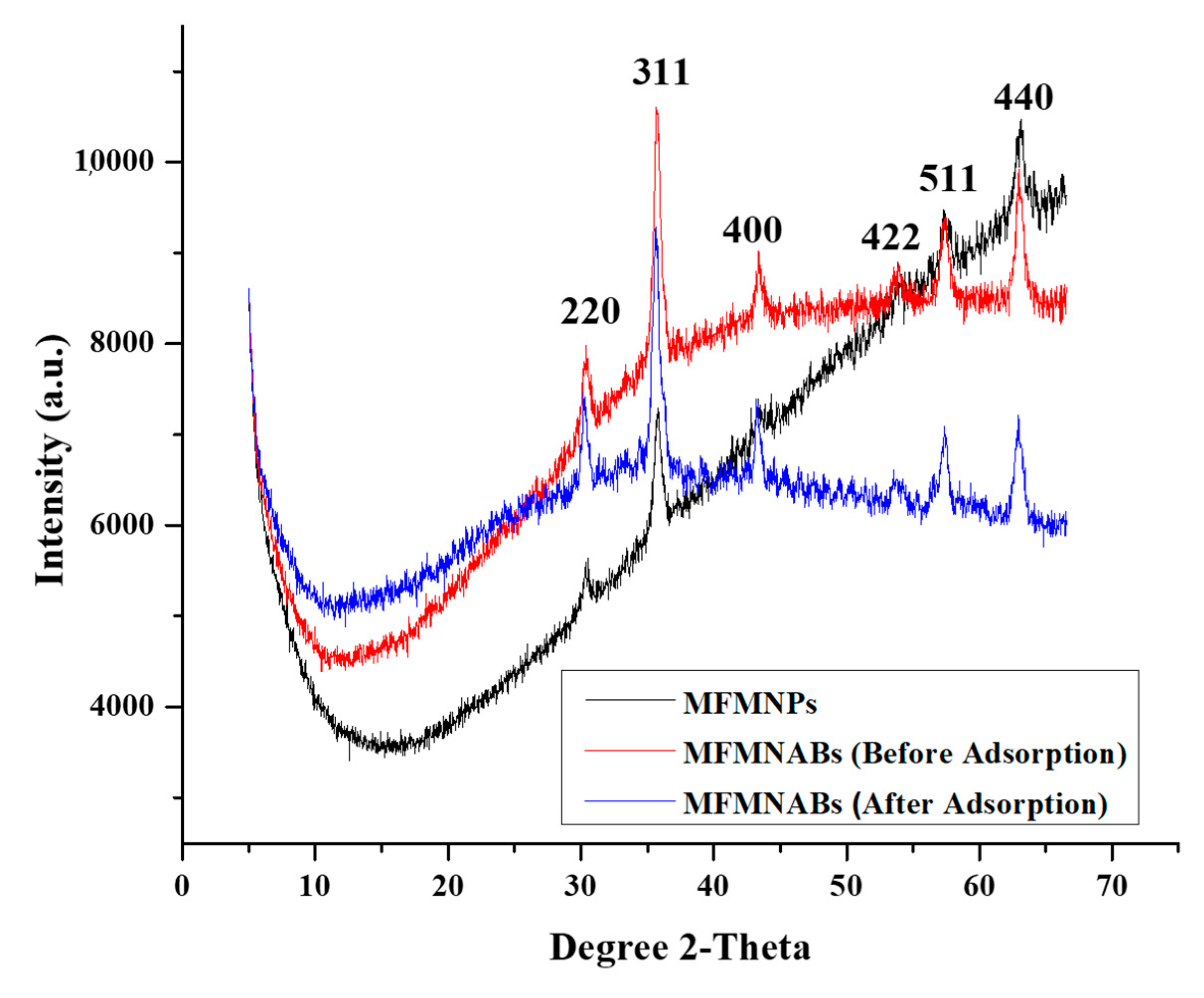

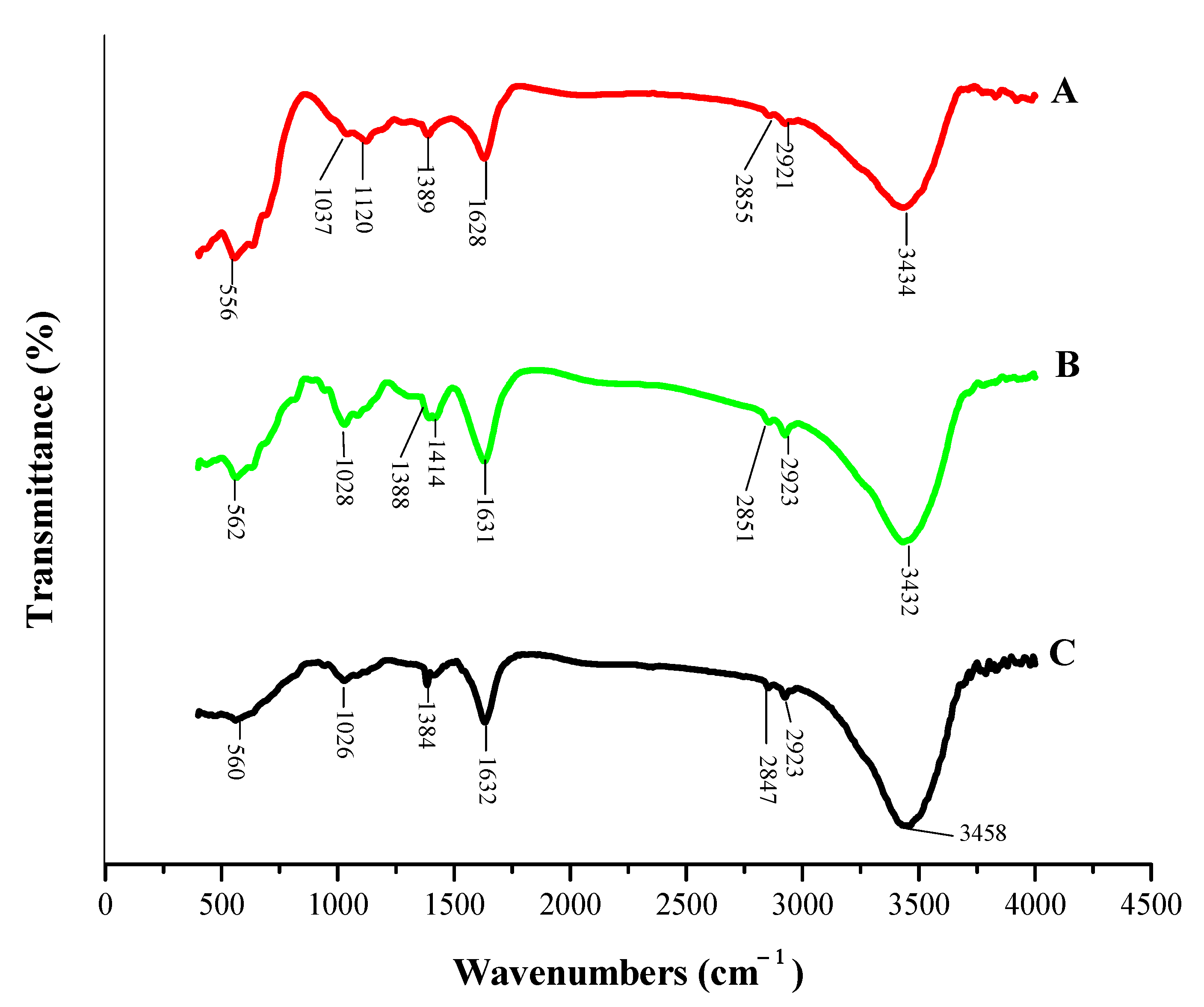


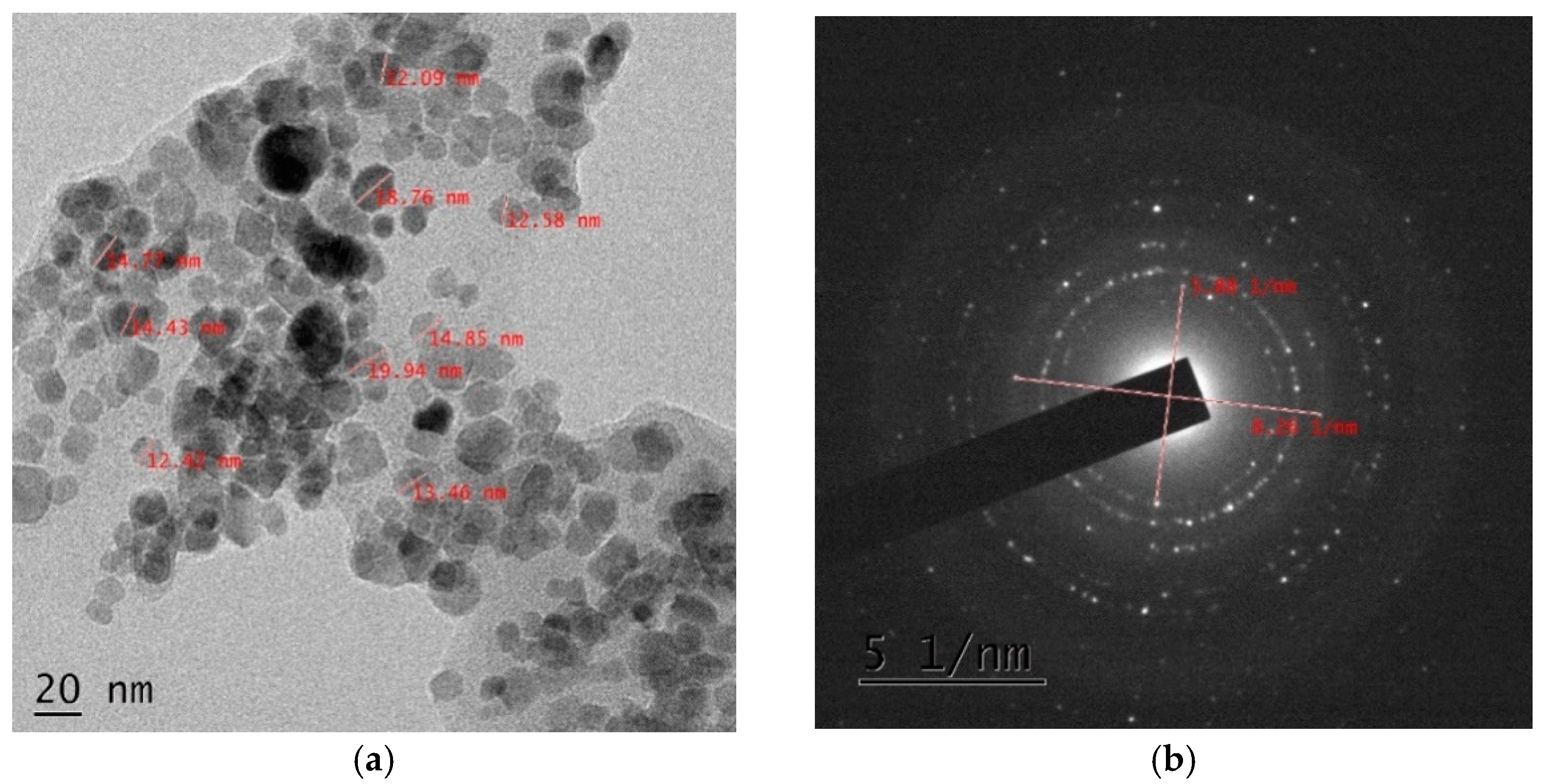

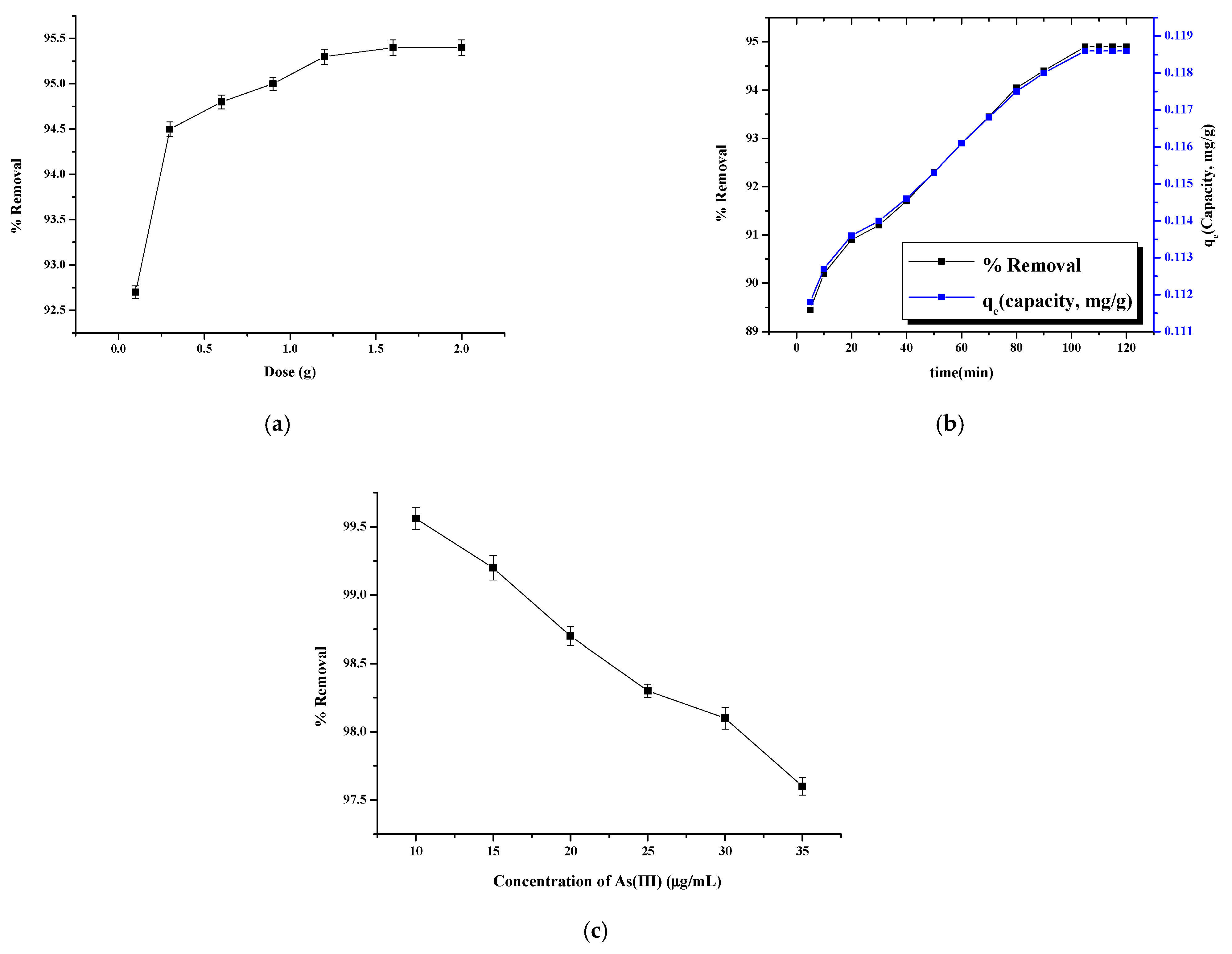
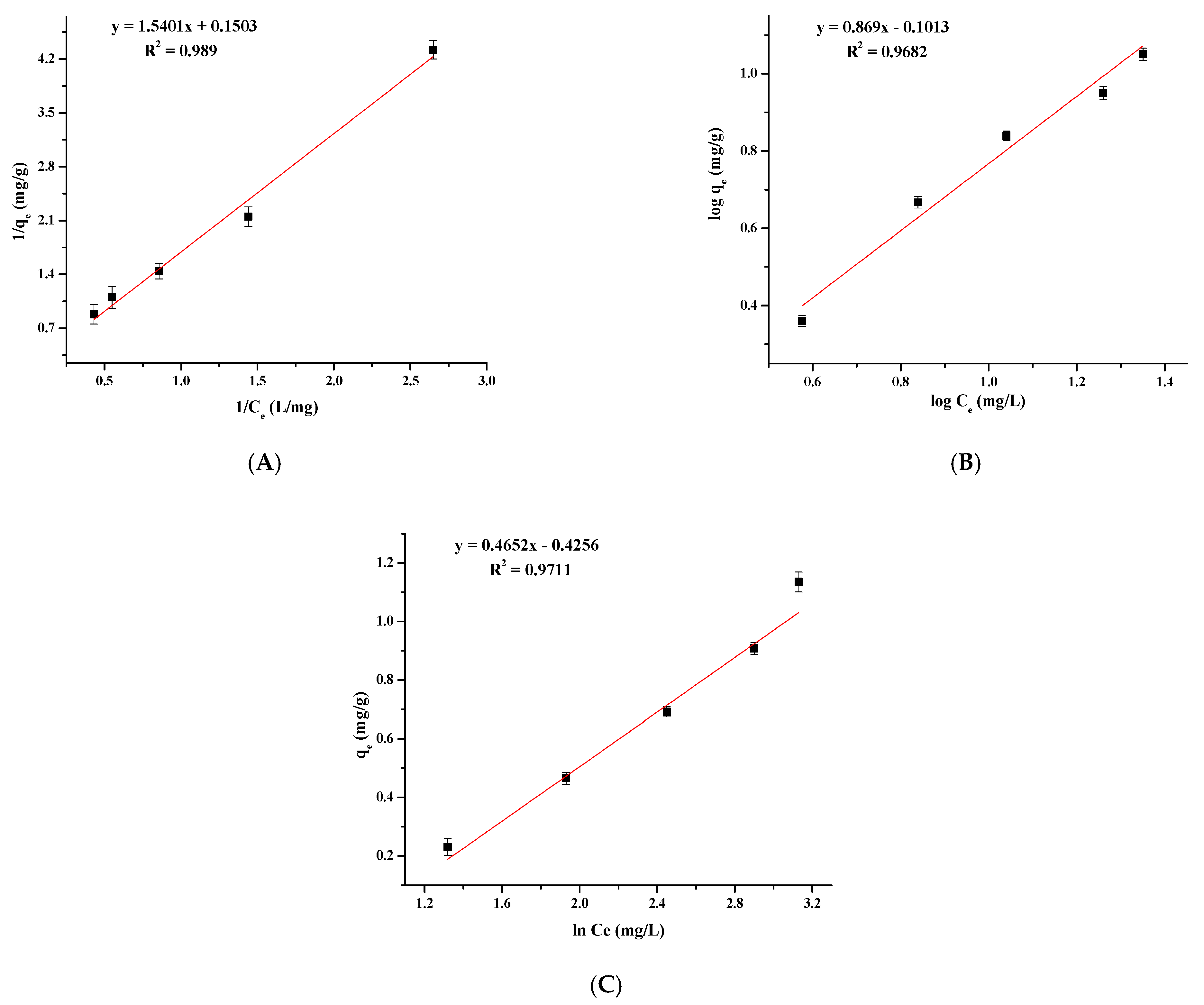




| Substance | Most Intense Peak (2θ, Degree) | Most Intense Peak (θ, Degree) | hkl | FWHM * of Most Intense Peak (β, Radian) | Size of the Particles (D, nm) |
|---|---|---|---|---|---|
| MFMNPs | 35.77 | 17.88 | 311 | 0.0144 | 17.04 |
| MFMNABs (Before adsorption) | 35.18 | 17.59 | 311 | 0.035 | 12.95 |
| MFMNABs (After adsorption) | 35.66 | 17.83 | 311 | 0.013 | 20.68 |
| HR-TEM | XRD | ||
|---|---|---|---|
| d-spacing (nm) | D (nm) | d-spacing (nm) | D (nm) |
| 0.242 | 12.68 | 0.254 | 12.95 |
| Isotherm | Values of Parameters | |||
|---|---|---|---|---|
| Langmuir | qmax (mg g−1) 6.6533 | KL 0.0975 | R2 0.989 | RL 0.3389 |
| Freundlich | KF (mg g−1) (mg L−1)n 0.7919 | n 1.1507 | R2 0.9682 | - |
| Temkin | B1 0.4625 | KT (L mg−1) 0.3984 | R2 0.9711 | - |
| Models | Kinetics Parameters | ||
|---|---|---|---|
| Pseudo-First-Order | k1 (min−1) | qe (mg g−1) | R2 |
| 0.0223 | 2.492 | 0.9317 | |
| Pseudo-Second- Order | k2 (g mg−1 min−1) | qe (mg g−1) | R2 |
| 0.08 | 0.1177 | 0.9998 | |
| Intra-particle Diffusion | kd (mg g−1 min−1) | C (mg g−1) | R2 |
| 8.0456 | 0.1099 | 0.9758 | |
| Elovich model | A (mg g−1 min−2) | β (g mg−1 min−1) | R2 |
| 1.01035 | 0.397 | 0.9601 | |
| Adsorbents | Adsorption Capacity (mg/g) | References |
|---|---|---|
| Guava leaf biomass | 1.05 | [83] |
| Mango bark | 1.25 | [83] |
| Bagasse | 1.35 | [83] |
| Ferric hydroxide microcapsule-loaded alginate beads (FHMCA) | 3.80 | [84] |
| Modified saxaul ash | 4.20 | [85] |
| WTRs (water treatment residuals) loaded alginate beads | 3.40 | [86] |
| Iron impregnated AC from Lapsi seed stone | 2.00 | [87] |
| Magnetic nanoparticle obtained from metallic wool | 2.20 | [88] |
| Magnetite-maghemite nanoparticle | 3.69 | [89] |
| Hybrid (polymeric/inorganic) fibrous sorbent | 75.67 | [90] |
| Hybrid material zirconium polyacrylamide (ZrPACM-43) | 41.48 | [91] |
| Laterite soil (batch adsorption and fixed bed column) | 0.18 69.22 | [92] |
| Methionine functionalized magnetic nanoparticles | 6.65 | Present study |
Publisher’s Note: MDPI stays neutral with regard to jurisdictional claims in published maps and institutional affiliations. |
© 2021 by the authors. Licensee MDPI, Basel, Switzerland. This article is an open access article distributed under the terms and conditions of the Creative Commons Attribution (CC BY) license (https://creativecommons.org/licenses/by/4.0/).
Share and Cite
Lilhare, S.; Mathew, S.B.; Singh, A.K.; Carabineiro, S.A.C. Calcium Alginate Beads with Entrapped Iron Oxide Magnetic Nanoparticles Functionalized with Methionine—A Versatile Adsorbent for Arsenic Removal. Nanomaterials 2021, 11, 1345. https://doi.org/10.3390/nano11051345
Lilhare S, Mathew SB, Singh AK, Carabineiro SAC. Calcium Alginate Beads with Entrapped Iron Oxide Magnetic Nanoparticles Functionalized with Methionine—A Versatile Adsorbent for Arsenic Removal. Nanomaterials. 2021; 11(5):1345. https://doi.org/10.3390/nano11051345
Chicago/Turabian StyleLilhare, Surbhi, Sunitha B. Mathew, Ajaya K. Singh, and Sónia A. C. Carabineiro. 2021. "Calcium Alginate Beads with Entrapped Iron Oxide Magnetic Nanoparticles Functionalized with Methionine—A Versatile Adsorbent for Arsenic Removal" Nanomaterials 11, no. 5: 1345. https://doi.org/10.3390/nano11051345
APA StyleLilhare, S., Mathew, S. B., Singh, A. K., & Carabineiro, S. A. C. (2021). Calcium Alginate Beads with Entrapped Iron Oxide Magnetic Nanoparticles Functionalized with Methionine—A Versatile Adsorbent for Arsenic Removal. Nanomaterials, 11(5), 1345. https://doi.org/10.3390/nano11051345








